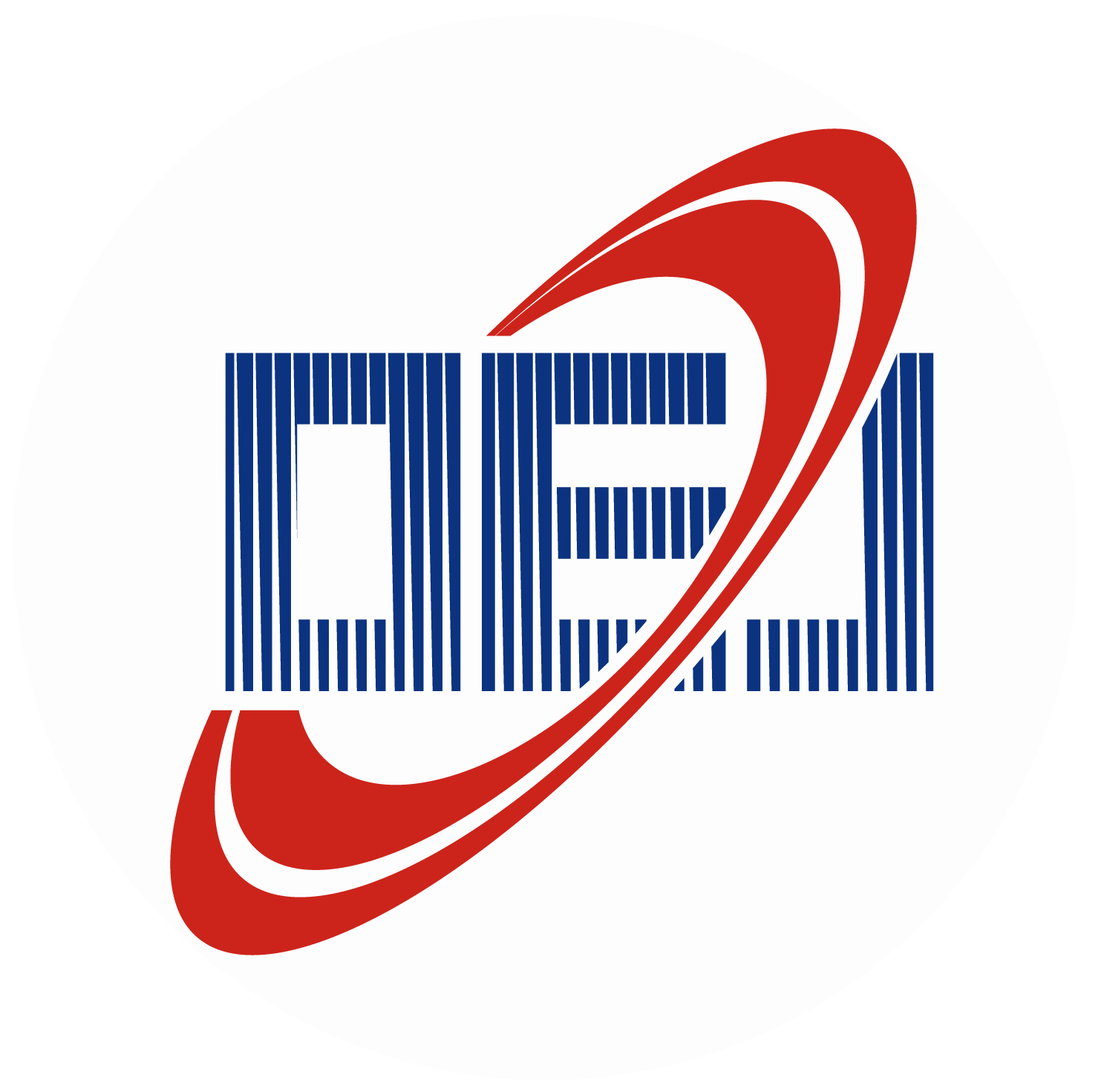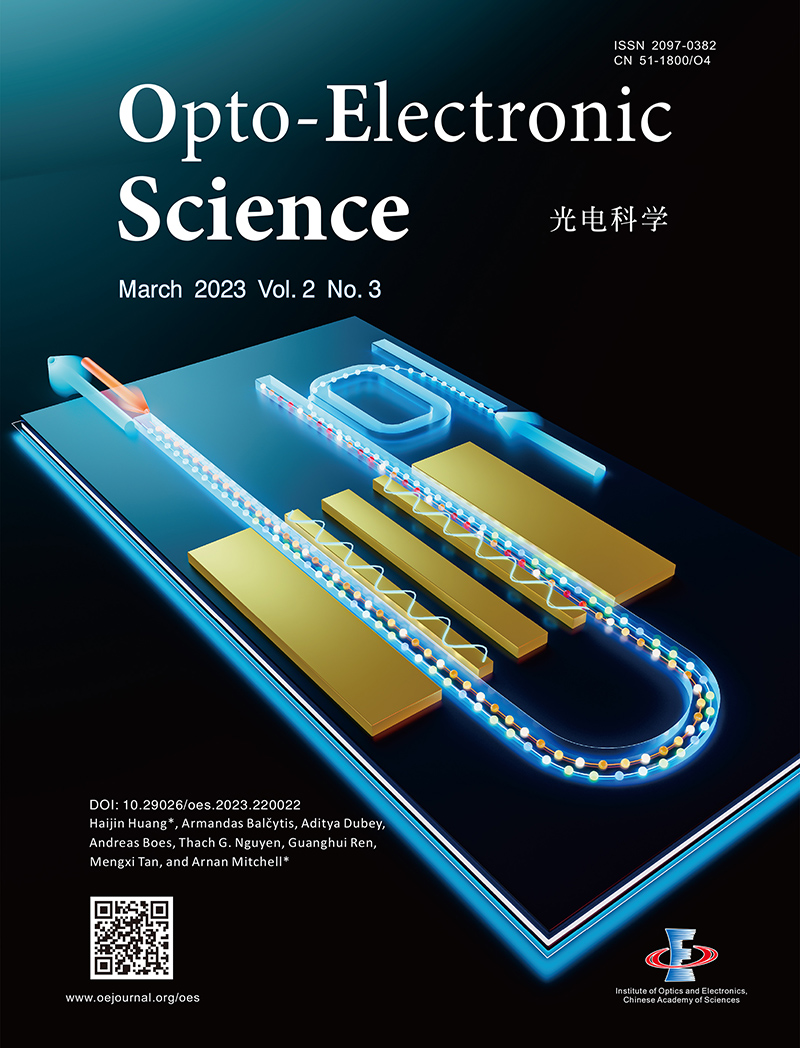| Citation: | Han JL, Li MQ, Wu RB et al. High fiber-to-fiber net gain in erbium-doped thin film lithium niobate waveguide amplifier as an external gain chip. Opto-Electron Sci 4, 250004 (2025). doi: 10.29026/oes.2025.250004 |
High fiber-to-fiber net gain in erbium-doped thin film lithium niobate waveguide amplifier as an external gain chip
-
Abstract
Miniaturized erbium-doped waveguide amplifiers attracted great interests in recent decades due to their high gain-efficiency and function-scalability in the telecom C-band. In this work, an erbium-doped thin film lithium niobate waveguide amplifier achieving >10 dB off-chip (fiber-to-fiber) net gain and >20 mW fiber-output amplified power is demonstrated, thanks to the low-propagation-loss waveguides and robust waveguide edge-couplers prepared by the photolithography assisted chemomechanical etching technique. Systematic investigation on the fabricated waveguide amplifiers reveals remarkable optical gain around the peak wavelength of1532 nm as well as the low fiber-coupling loss of −1.2 dB/facet. A fiber Bragg-grating based waveguide laser is further demonstrated using the fabricated waveguide amplifier as the external gain chip, which generates >2 mW off-chip power continuous-wave lasing around the gain peak at1532 nm. The unambiguous demonstration of fiber-to-fiber net gain of the erbium-doped thinfilm lithium niobate (TFLN) waveguide amplifier as well as its external gain chip application will benefit diverse fields demanding scalable gain elements with high-speed tunability. -

-
References
[1] Poole SB, Payne DN, Mears RJ et al. Fabrication and characterization of low-loss optical fibers containing rare-earth ions. J Lightwave Technol 4, 870–876 (1986). doi: 10.1109/JLT.1986.1074811 [2] Mears RJ, Reekie L, Jauncey IM et al. Low-noise erbium-doped fibre amplifier operating at 1.54μm. Electron Lett 23, 1026–1028 (1987). doi: 10.1049/el:19870719 [3] Jauregui C, Limpert J, Tünnermann A. High-power fibre lasers. Nat Photonics 7, 861–867 (2013). doi: 10.1038/nphoton.2013.273 [4] Bradley JDB, Pollnau M. Erbium-doped integrated waveguide amplifiers and lasers. Laser Photonics Rev 5, 368–403 (2011). doi: 10.1002/lpor.201000015 [5] Liu Y, Qiu ZR, Ji XR et al. A photonic integrated circuit-based erbium-doped amplifier. Science 376, 1309–1313 (2022). doi: 10.1126/science.abo2631 [6] Vázquez-Córdova SA, Dijkstra M, Bernhardi EH et al. Erbium-doped spiral amplifiers with 20 dB of net gain on silicon. Opt Express 22, 25993–26004 (2014). doi: 10.1364/OE.22.025993 [7] Brüske D, Suntsov S, Rüter CE et al. Efficient ridge waveguide amplifiers and lasers in Er-doped lithium niobate by optical grade dicing and three-side Er and Ti in-diffusion. Opt Express 25, 29374–29379 (2017). doi: 10.1364/OE.25.029374 [8] Mu JF, Dijkstra M, Korterik J et al. High-gain waveguide amplifiers in Si3N4 technology via double-layer monolithic integration. Photonics Res 8, 1634–1641 (2020). doi: 10.1364/PRJ.401055 [9] Bonneville DB, Osornio-Martinez CE, Dijkstra M et al. High on-chip gain spiral Al2O3: Er3+ waveguide amplifiers. Opt Express 32, 15527–15536 (2024). doi: 10.1364/OE.516705 [10] Jia YC, Wu JW, Sun XL et al. Integrated photonics based on rare-earth ion-doped thin-film lithium niobate. Laser Photonics Rev 16, 2200059 (2022). doi: 10.1002/lpor.202200059 [11] Chen ZX, Xu Q, Zhang K et al. Efficient erbium-doped thin-film lithium niobate waveguide amplifiers. Opt Lett 46, 1161–1164 (2021). doi: 10.1364/OL.420250 [12] Luo Q, Yang C, Hao ZZ et al. On-chip erbium-doped lithium niobate waveguide amplifiers. Chin Opt Lett 19, 060008 (2021). doi: 10.3788/COL202119.060008 [13] Yan XS, Liu YA, Wu JW et al. Integrated spiral waveguide amplifiers on erbium-doped thin-film lithium niobate. arXiv: 2105.00214, 2021. https://doi.org/10.48550/arXiv.2105.00214. [14] Zhou JX, Liang YT, Liu ZX et al. On-chip integrated waveguide amplifiers on erbium-doped thin-film lithium niobate on insulator. Laser Photonics Rev 15, 2100030 (2021). doi: 10.1002/lpor.202100030 [15] Liang YT, Zhou JX, Liu ZX et al. A high-gain cladded waveguide amplifier on erbium doped thin-film lithium niobate fabricated using photolithography assisted chemo-mechanical etching. Nanophotonics 11, 1033–1040 (2022). doi: 10.1515/nanoph-2021-0737 [16] Cai ML, Wu K, Xiang JM et al. Erbium-doped lithium niobate thin film waveguide amplifier with 16 dB internal net gain. IEEE J Sel Top Quantum Electron 28, 8200608 (2022). [17] Yan CL, Wang SQ, Zhao S et al. A short high-gain waveguide amplifier based on low concentration erbium-doped thin-film lithium niobate on insulator. Appl Phys Lett 122, 123503 (2023). doi: 10.1063/5.0137678 [18] Wu JW, Yan XS, Wang XY et al. Efficient integrated amplifier-assisted laser on erbium-doped lithium niobate. ACS Photonics 11, 2114–2122 (2024). doi: 10.1021/acsphotonics.4c00391 [19] Cai ML, Li TY, Zhang XJ et al. Gain dynamics in integrated waveguide amplifier based on erbium-doped thin-film lithium niobate. ACS Photonics 11, 4923–4932 (2024). doi: 10.1021/acsphotonics.4c01433 [20] Wu RB, Wang M, Xu J et al. Long low-loss-litium niobate on insulator waveguides with sub-nanometer surface roughness. Nanomaterials 8, 910 (2018). doi: 10.3390/nano8110910 [21] Wang M, Wu RB, Lin JT et al. Chemo-mechanical polish lithography: a pathway to low loss large-scale photonic integration on lithium niobate on insulator. Quantum Eng 1, e9 (2019). doi: 10.1002/que2.9 [22] Bao R, Fang ZW, Liu J et al. An erbium-doped waveguide amplifier on thin film lithium niobate with an output power exceeding 100 mW. Laser Photonics Rev 19, 2400765 (2025). doi: 10.1002/lpor.202400765 [23] Wu RB, Gao L, Liang YT et al. High-production-rate fabrication of low-loss lithium niobate electro-optic modulators using photolithography assisted chemo-mechanical etching (PLACE). Micromachine 13, 378 (2022). doi: 10.3390/mi13030378 [24] Zhang MR, Wu JY, Zhao ZY et al. Efficient and polarization insensitive edge coupler based on cascaded vertical waveguide tapers. Opt Express 31, 31796–31805 (2023). doi: 10.1364/OE.498764 [25] Huang CH, McCaughan L, Gill DM. Evaluation of absorption and emission cross sections of Er-doped LiNbO3 for application to integrated optic amplifiers. J Lightwave Technol 12, 803–809 (1994). doi: 10.1109/50.293972 [26] Thiel CW, Macfarlane RM, Böttger T et al. Optical decoherence and persistent spectral hole burning in Er3+: LiNbO3. J Lumin 130, 1603–1609 (2010). doi: 10.1016/j.jlumin.2009.12.020 [27] Brinkmann R, Baumann I, Dinand M et al. Erbium-doped single- and double-pass Ti: LiNbO3 waveguide amplifiers. IEEE J Quantum Electron 30, 2356–2360 (1994). doi: 10.1109/3.328589 [28] Huang CH, McCaughan L. 980-nm-pumped Er-doped LiNbO3 waveguide amplifiers: a comparison with 1484-nm pumping. IEEE J Sel Top Quantum Electron 2, 367–372 (1996). doi: 10.1109/2944.577396 [29] Veasey DL, Gary JM, Amin J et al. Time-dependent modeling of erbium-doped waveguide lasers in lithium niobate pumped at 980 and 1480 nm. IEEE J Quantum Electron 33, 1647–1662 (1997). doi: 10.1109/3.631259 [30] Dinard M, Sohler W. Theoretical modeling of optical amplification in Er-doped Ti: LiNbO3 waveguides. IEEE J Quantum Electron 30, 1267–1276 (1994). doi: 10.1109/3.303692 [31] Giles CR, Desurvire E. Modeling erbium-doped fiber amplifiers. J Lightwave Technol 9, 271–283 (1991). doi: 10.1109/50.65886 [32] Desurvire E, Zyskind JL, Simpson JR. Spectral gain hole-burning at 1.53 μm in erbium-doped fiber amplifiers. IEEE Photonics Technol Lett 2, 246–248 (1990). doi: 10.1109/68.53251 [33] Han JL, Li MQ, Dong QN et al. Suppression of parasitic lasing in erbium doped thin film lithium niobate waveguide amplifier by integrated wavelength division multiplexer. APL Photonics 9, 126108 (2024). doi: 10.1063/5.0232333 -
Supplementary Information
Supplementary information for High fiber-to-fiber net gain in erbium-doped thin film lithium niobate waveguide amplifier as an external gain chip 
-
Access History

Article Metrics
-
Figure 1.
Design and modal evolution of the SSC-integrated EDWA chip. (a) the schematic of the SSC-integrated EDWA chip. (b) The simulated modal evolution in the SSC region with the insets (i–v) showing the cross-section modal distribution at different propagation positions (dashed lines). The bottom inset shows the fluorescence microscope image of the SSC region. (c) The measured SSC-output mode profile. (d) The measured UHNA7 output mode profile.
-
Figure 2.
Gain characterization of the EDWA chip. (a) The experimental schematic. (b) The Er3+ energy-level diagram. (c) The photoluminescence spectrum from the TFLN-waveguide. (d) The fiber-to-fiber net gain curves measured at two different signal wavelengths. (e) The fiber-to-fiber transmission loss curves measured at four different signal wavelengths. (f) The spectra of the input signal and the output signal with/without pump measured at −14 dBm input power. (g) The input and output signal spectra measured at 10 dBm input power. The insets in (f) and (g) show the enlarged spectra around the signal wavelength.
-
Figure 3.
Gain saturation of the ASE from the EDWA chip. (a) Forward ASE spectra evolution with pump powers. (b) Backward ASE spectra evolution with pump powers. (c) The normalized ASE spectra at low (unsaturated) and high (saturated) pump powers. (d) The spectral linewidths of the ASE-peak at
1532 nm vs pump powers. The insets in (a) and (b) show the ASE power saturation at three different wavelengths. -
Figure 4.
External laser generation using the EDWA chip. (a) The experimental schematic. (b) The reflection spectra of the FBGs with two different rates. (c) The generated laser powers vs coupled pump powers, with the laser spectra evolution around the pump threshold shown in the inset. (d) The laser spectrum at the maximum output power of 2.1 mW with the enlarged laser spectral profile shown in the inset. (e) The generated laser spectra with the FBG output couplers of different reflection rates.

 E-mail Alert
E-mail Alert RSS
RSS



 DownLoad:
DownLoad:





